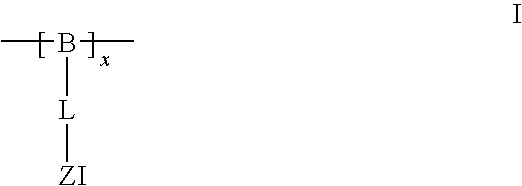Layered non-fouling, antimicrobial antithrombogenic coatings
a coating and antimicrobial technology, applied in the field of immobilized non-fouling coatings, can solve the problems of arbitrary degradation of the material or release of the coating, more likely to foul, and non-fouling conventional or non-fouling materials, and achieve the effects of improving non-fouling performance, superior non-fouling performance, and stably binding the topcoa
- Summary
- Abstract
- Description
- Claims
- Application Information
AI Technical Summary
Benefits of technology
Problems solved by technology
Method used
Image
Examples
example 1
Preparation of a Coated Substrate
[0200]Preparation of an Undercoating
[0201]An undercoating, with reactive functional groups for crosslinking, was prepared through free radical polymerization. 2-aminoethyl methacrylate (AEMA, 20-80 mol %), lauryl methacrylate (LMA, 0-50 mol %), 2-hydroxypropyl methacrylate (HPMA, 0-50 mol %) and 3-(trimethoxysilyl)propyl methacrylate (TMOSMA, 0-25 mol %) were mixed in methanol. Azobisisobutyronitrile (AIBN), an initiator, was added and the reaction solution was heated to 60-65° C. The reaction was allowed to proceed for 12-24 hours at 60-65 C, with gentle stirring, under nitrogen. The crude polymer was purified by dialysis against methanol.
[0202]Preparation of a Top Coating
[0203]A top coating, containing reactive functional groups for crosslinking, was prepared through free radical polymerization. Sulfobetaine methacrylate (SBMA, 25-70 mol %), glycidyl methacrylate methacrylate (GMA, 10-50 mol %), and 2-hydroxypropyl methacrylate (HPMA, 0-50 mol %) w...
example 2
Synthesis of an Undercoating
[0206]A nitrogen purged solution of 3.4 g laurylmethacrylate, 4.25 g hydroxypropylmethacrylate, 1.56 g trimethoxysilylpropylmethacrylate, 1.20 g aminoethylmethacrylamide hydrochloride salt, and 0.40 g azoisobutyronitrile in 90 mL anhydrous methanol was heated (64° C.) 14 h. After allowing the mixture to cool to room temperature, the solution was dialyzed against anhydrous methanol using benzylated dialysis tubing to afford a solution of undercoating in methanol.
example 3
Synthesis of a Top Coat
[0207]A nitrogen purged solution of 1.08 g glycidylmethacrylate, 4.2 g N-(3-sulfopropyl)-N-methacryloxyethyl-N,N-dimethylammonium betaine, 0.24 g azoisobutyronitrile in 90 mL anhydrous methanol was heated (64° C.) 14 h. After allowing the solution to cool to room temperature, the solution was decanted from the precipitate. The precipitate was washed twice with anhydrous methanol and dried under vacuum. This topcoat is referred to as the H topcoat.
PUM
| Property | Measurement | Unit |
|---|---|---|
| Temperature | aaaaa | aaaaa |
| Fraction | aaaaa | aaaaa |
| Fraction | aaaaa | aaaaa |
Abstract
Description
Claims
Application Information
 Login to View More
Login to View More - R&D
- Intellectual Property
- Life Sciences
- Materials
- Tech Scout
- Unparalleled Data Quality
- Higher Quality Content
- 60% Fewer Hallucinations
Browse by: Latest US Patents, China's latest patents, Technical Efficacy Thesaurus, Application Domain, Technology Topic, Popular Technical Reports.
© 2025 PatSnap. All rights reserved.Legal|Privacy policy|Modern Slavery Act Transparency Statement|Sitemap|About US| Contact US: help@patsnap.com



